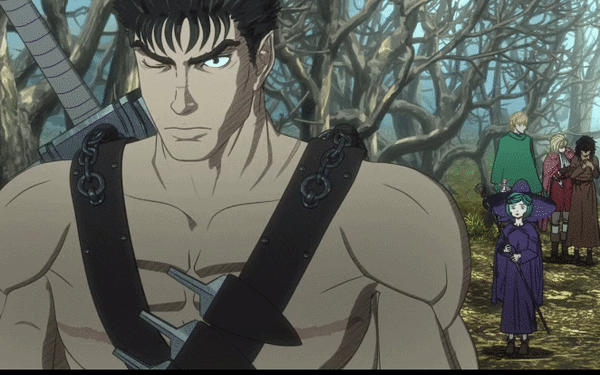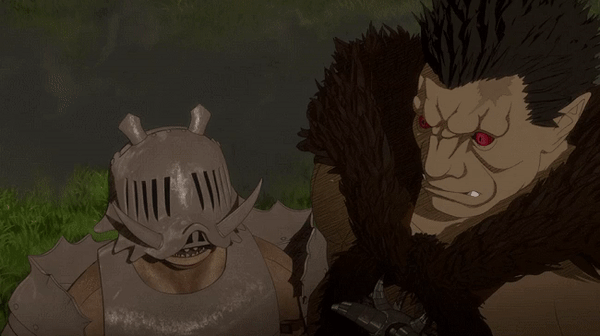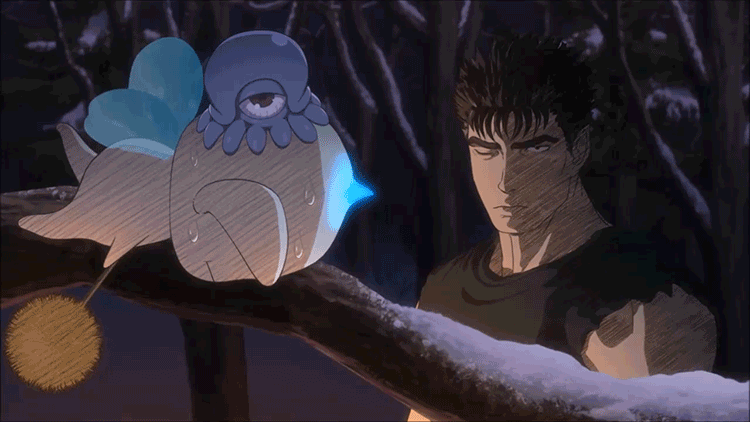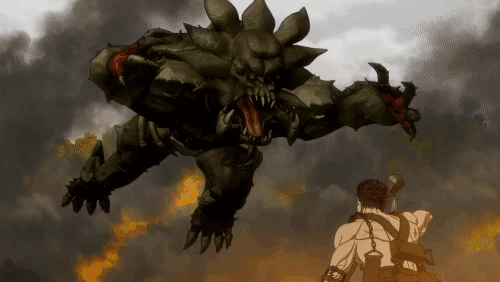What Happened Between The Anime Man And Lost Pause
What the Heck Happened to Berserk?
by Callum May,"I want to see what will happen if nosotros make a Berserk TV anime mainly with 3DCG animation." - Tetsuro Satomi (LIDEN FILMS)

To phone call Berserk'southward new adaptation "divisive" would be an understatement. Fan reactions to the show'due south CG visuals accept been overwhelmingly negative, ranging from incredulity to hatred. Although the show retains a defended audition thanks to the popularity of its source textile, information technology'southward hard to ignore the clear disappointment that dominates forum discussions and social media. No matter where yous go, the same question is always asked:
"What the Heck Happened to Berserk?"
From arguments to delays to outsourcing, this is the story of the squad of 3D artists and animators who were tasked with adapting the Berserk manga without the tools, experience, or planning they needed to succeed.
An Unrealistic Proposal
When Tetsuro Satomi stated that he wanted to produce a Berserk testify with 3DCG animation, it's likely that he didn't understand how hard the project would really be. GEMBA president Hideki Kuraku agreed with Satomi's sentiment, but he also idea that information technology would testify to exist a great claiming for their studio.
With the reward of hindsight, it'due south clear that this challenge was far also great, but even at the time, the proposal was considered wildly ambitious. GEMBA was set upwards in 2006 every bit a subsidiary of Digital Frontier (the CG studio behind GANTZ: O) and their mission statement is to exist a "cutting border" force in their industry.
Unfortunately for them, however, GEMBA had never been in accuse of a full-length animation production earlier.

Anime is produced through the efforts of many hands, and although some studios can create the animation for an entire series or movie in-house, that process ends upwardly taking far too long in nigh cases. Thankfully, near blitheness studios in Japan don't create their work alone. GEMBA has contributed to diverse anime through "CG Production Assistance", "CG Background Cosmos" and "VFX Production", but they'd never held the crown of "Chief Blitheness Product Studio" before Berserk. Beyond the daunting weight of chief animation production, this likewise left GEMBA with the responsibleness of planning and analogous the whole project. Fifty-fifty with the assistance of LIDEN FILMS, the studio was on their own in solving problems when things didn't turn out how they wanted for their first series project.
But to say the staff lacked foresight would be unfair. Many voices within GEMBA spoke out every bit the project was beingness greenlit, skeptical near their ability to produce such taxing piece of work. The arguments somewhen subsided and the whole staff followed LIDEN FILMS into battle unanimously.
Then forth with the backing of LIDEN FILMS' parent visitor, Ultra Super Pictures and NBCUniversal, GEMBA put on a dauntless face up and strolled into the darkness—merely to encounter a new obstruction.
Director Shin Itagaki
Some anime staff have referred to the dynamic between the producer and the director as a l/50 relationship. The director is responsible for making artistic decisions, and the producer makes sure everything ends up working out according to schedule. When both respect the limitations of the other, a projection can run smoothly.
Berserk started product in the leap of 2015, only it took them until December just to make up one's mind how the series should wait.

It'south a mystery why Shin Itagaki was on this Berserk projection to begin with. It's possible that someone at Ultra Super Pictures recommended him, considering they own Studio Trigger, which is the electric current home of many of Itagaki'south former co-workers. It'south been argued that Itagaki's history with brightly-colored comedy and giddy action serial would clash with the nighttime and gritty globe of Berserk, just the existent cause of the conflict turned out to be Itagaki'southward insistence upon a very detail aesthetic that proved also difficult to achieve.
3D blitheness is the only applied way to adjust Berserk to a boob tube series in today'due south anime production environment. With the huge corporeality of particular present in Kentaro Miura'southward original artwork, finding a team that could consistently animate such complexity would be extremely hard. This is likely why other 3D adaptations of Berserk had been greenlit earlier GEMBA'due south endeavour. Creating Berserk as a 3D/second hybrid would exist the but way to accurately retain what makes Berserk great visually with the resources available to these studios.
This hybridization was the goal Shin Itagaki strove for. He set out to replicate Miura's art with highly detailed models and backgrounds, but these demands caused a conflict at GEMBA. 3D animation production entails a long stretch of unique difficulties, and creating animation that replicates the await of 2D isn't so easy either. Nonetheless, Itagaki pursued his vision despite opposition from staff members concerned about his style's technical feasibility.
The event was a lot of wasted time. The premiere date of July 1st 2016 was bearing down on them, but due to so much indecision during the planning phase, they lost over half a year of production lead time. Fifty-fifty when NBCUniversal required a trailer be produced, they hadn't yet decided how the bodily show was going to look.
The first teaser trailer for the Berserk anime was completed in August of 2015 and released four months afterwards in December, coinciding with the announcement of the project. Only behind the scenes, the staff was finally reaching a compromise with Itagaki on how the evidence would actually wait. The beginning step was to scrap all the assets they'd made for the teaser trailer and start creating 150 new character models (including battle damage models) from scratch.

The End Result
At best, we can hope that someone on the team felt vindicated by getting to say "I told yous then", but the product problems that followed hurt anybody. In add-on to all that wasted fourth dimension arguing, Itagaki'due south ideas equally director caused the near delays, pregnant that they had less time to work on the show as the deadline apace approached. The new models went into production in Jan, and the studio finally started animating them in March of 2016, just four months before the serial was meant to air.
Then a series of predictable issues followed. Not only were the highly detailed character models as well much strain on the viewport in their 3DSMax software, the staff had difficulties getting these models to return at all. Without the time to notice a new solution, the staff were forced to simplify these models that were originally meant to replicate equally much detail from the manga every bit possible. The removal of lines and edges meant that their designs could now be practically animated with the hardware at GEMBA, but they also deviated greatly from their original plans for the wait of the show.

The staff had hoped to return out the 3D backgrounds with Global Illumination, a arrangement that calculates the reflection of light to create suitably atmospheric environments. But every bit the schedule became tighter, they needed to render out each of these backgrounds in less than ten minutes, which was not nearly enough time for that utility. The exclusion of Global Illumination meant that Berserk's backgrounds never stood out in the way they could have.
Shin Itagaki wanted to implement what the staff at GEMBA referred to as "impact-up lines", the unique style of hatch-marker shading that tin be seen in the final product. This result, along with the show's 2D animation, was created at Berserk'due south second studio, Millepensee. The lines were to be automatically tracked onto the models in Adobe After Furnishings, merely it was not always a successful procedure. For swords, armor, and other detailed metallic objects, the staff had to spend time manually applying the unique texture.
Berserk had a large staff, just with so many of them working from outside the studio, they needed to develop custom tools that would let unity between the different rigging software used within and exterior GEMBA. This job mainly roughshod to the evidence's overworked technical managing director, Keita Mizuhashi. The staff joked that it was his task to handle the "demonic parts" of the product, which meant developing new custom tools, creating assets, and even managing the compositing procedure.

In the end, due to wasted time and an overly aggressive brief, the last production simply didn't end up like the staff originally wanted. Non merely had they been forced to compromise due to technical issues, merely they didn't even have time to try out new software that might have improved the quality.
Everyone on staff did what they could to create a smashing Berserk anime adaptation, and while information technology's easy to assign blame at various stages of product, the final product was an attempted labor of love, a disharmonism betwixt passion projection and reality. Between a producer eager to run across a new sequel, a director who wouldn't back down from his desire to recreate the original manga's look, and a staff who struggled to brand these demands possible under incommunicable time constraints, the ideal version of this Berserk anime only wasn't meant to be. In the January 2017 issue of CGWorld, a GEMBA producer said that he hoped this state of affairs would meliorate for the 2nd flavor. Sadly, recent episodes would suggest that non many of the staff's problems have been resolved.
Special thank you to Kim Morrissy for translation and inquiry help.
discuss this in the forum (lx posts) |
Feature homepage / archives
Source: https://www.animenewsnetwork.com/feature/2017-07-07/what-the-heck-happened-to-berserk/.117834
Posted by: sotogreped.blogspot.com

0 Response to "What Happened Between The Anime Man And Lost Pause"
Post a Comment